Satellite Imagery Analysis 2024/11/28
North Korea unveils its uranium enrichment facility for the first time - its scale and aims
Yuki Kobayashi (Research Fellow, Sasakawa Peace Foundation)
1. Uranium enrichment facility inspected by Kim Jong-un
On September 13, 2024, Rodon Sinmun, the official newspaper of the Workers' Party of Korea in North Korea, reported that Kim Jong-un had inspected a nuclear production facility and provided on-site guidance. The site visited by him includes a uranium enrichment facility that produces nuclear material for nuclear warheads, and this is the first time that the country has publicized the site of a uranium enrichment facility with photographs.
Uranium enrichment facilities are known to be located in Nyongbon in the southeastern part of the country, where nuclear facilities are concentrated. In June of this year, the International Atomic Energy Agency (IAEA) stated that a uranium enrichment facility similar to Nyongbon is believed to be in the completion stage of construction on the site of a nuclear-related facility being built in Kanson, a suburb of the capital Pyongyang.[1] In addition, the IAEA stated at the end of December 2023, "There are signs that the experimental light water reactor under construction at Nyongbon has reached criticality. There are concerns that plutonium will be extracted through reprocessing of spent fuel and diverted to nuclear weapons."[2] The IAEA is alarmed that North Korea may move to increase its nuclear capability by strengthening its production of nuclear materials.
In this context, what is North Korea's intention in revealing its uranium enrichment facility for the first time? The Sasakawa Peace Foundation analyzed photos published in the Rodon Sinmun and newly obtained satellite images to find out North Korea's the production capacity of uranium for weapons use and its aims.
2. Uranium enrichment in North Korea
(1) What is uranium enrichment?
The process of uranium enrichment is essential to the use of nuclear energy. Natural uranium contains only 0.7% uranium-235, which fissions to emit enormous amounts of thermal energy, and the rest is composed of non-fissionable uranium-238. Therefore, it directly cannot be used as fuel for nuclear reactors or for nuclear weapons and must be processed to increase its ratio by separating uranium-235 from uranium-238 using a centrifuge or other means. As shown in the figure, low-enriched uranium with a higher percentage of uranium 235 (3~5%) is used for ordinary nuclear reactors. Once this enrichment technology of about 5% is established, it will theoretically be possible to produce 90% nuclear-weapons-grade highly enriched uranium. Centrifuges for enrichment separate uranium-235 and uranium-238 by centrifugal force, similar to the dehydrator in a washing machine, but they must rotate at supersonic speeds and require advanced technology. As discussed below (see Table 1), North Korea has a long history of nuclear development and is believed to have already established nuclear-weapons-grade uranium enrichment technology.[3]
Figure
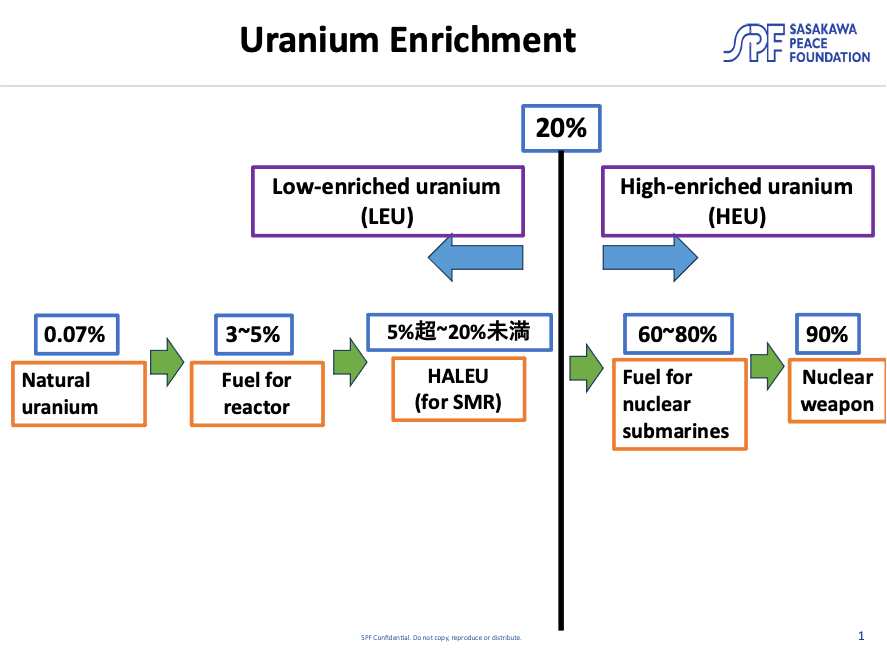
Source: Prepared by the author
(2) Analysis of uranium enrichment facilities: from publicly available photographs
The published photos give many indications about the size and characteristics of the uranium enrichment facility. First, the shape of the centrifuge suggests that it is North Korea's own centrifuge, modified based on a manufacturing method obtained via Pakistan ("Nuclear Black Market"[4] by Dr. Khan).
Photo 1: North Korean enrichment facility unveiled to the public
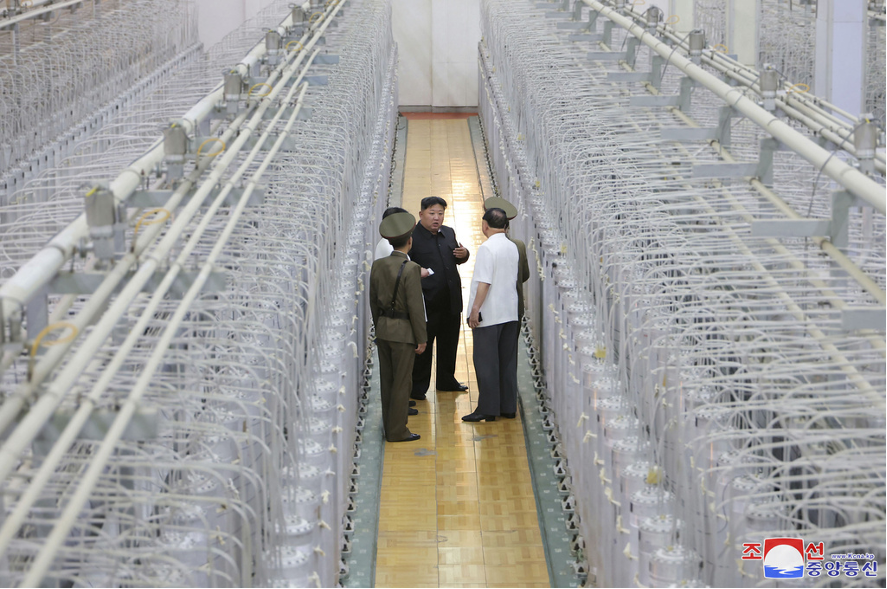
Source: Korean Central News Agency = Kyodo (provided by Kyodo News)
Photo 2: North Korean enrichment facility unveiled to the public
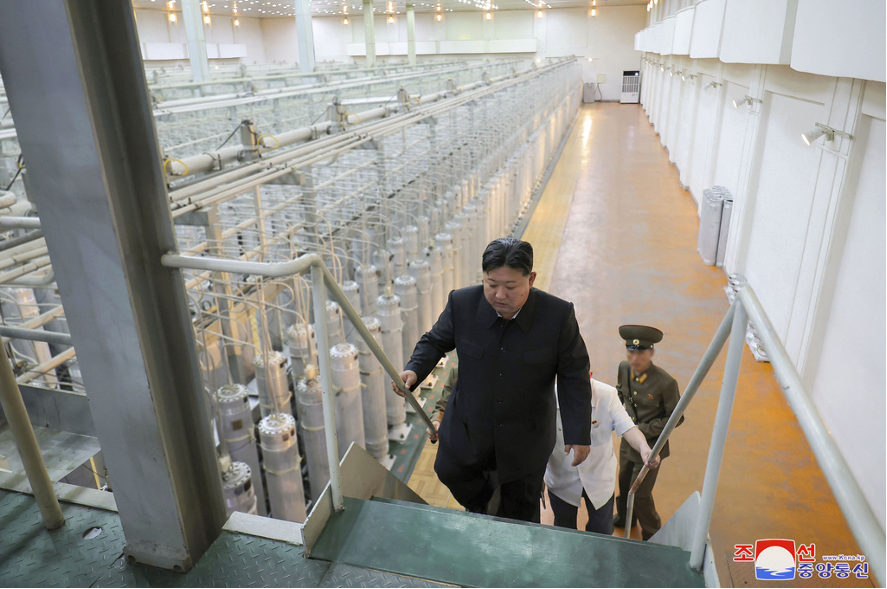
Source: Korean Central News Agency = Kyodo (provided by Kyodo News)
Although many countries are involved in uranium enrichment, including those that plan to use it for military purposes, only three companies in the world are capable of producing centrifuges on their own.
- URENCO: British-German-Dutch consortium
- Rosatom: Russia's national nuclear energy company
- Japan Nuclear Fuel Limited: Rokkasho Village, Aomori Prefecture
Except for centrifuges of the above companies, they were copied or improved upon by Dr. Khan, who had worked for URENCO, and who secretly stole the method of manufacturing centrifuges and passed them on to the "Nuclear Black Market". So the characteristics of each of these products are easy to grasp.
URENCO and JNFL's centrifuges are characterized by their long length (3~5 meters) per unit. Conversely, Russia has succeeded in reducing costs by mass-producing centrifuges with extremely short lengths (about 60 cm) and connecting several units together.[5] As a result, Russia has become the world's number one of the enriched uranium production for nuclear reactors.
Photo 1 shows that the centrifuges in this enrichment facility are about 1.5 meters tall, slightly shorter than the height of Kim Jong-un and the other observers, and do not show any of the characteristics of the above three companies. While it is unlikely that URENCO or JNFL would provide technical assistance to North Korea, there is no evidence of Russian technical assistance for these centrifuges. When Russia exports nuclear technology that can be used for military purposes, it requires, in principle, that the bilateral agreement clearly prohibits military diversion or that the exported country accept the IAEA safeguards (inspections and monitoring of nuclear facilities and materials).[6] Russia is not believed to have been involved in the facility so far, although its future is unknown given its current increasing military cooperation with North Korea.
On the other hand, the type of centrifuge manufacture that Dr. Kahn passed on to the "Nuclear Black Market," called P2, is 1.5 meters long and matches the characteristics of the centrifuges in the photo. According to Rodon Sinmun, Kim Jong-un stated at the site, "We must further increase the number of centrifuges, further enhance the individual capacity of the centrifuges, and further strengthen the foundation to produce weapons-grade nuclear materials by promoting the project to introduce a new type of centrifuge, which has already reached the completion stage, as planned”. It is reasonable to conclude that North Korea obtained the manufacturing method via the "Nuclear Black Market" and modified it on its own.
Next is the production scale of the uranium enrichment facility. The above two photos were taken at different locations, the number of centrifuges at each of them exceeds 1,000. Analysis of the six photos released to the public indicates that the facility as a whole has more than 10,000 machines. One thousand centrifuges can produce approximately 22 kilograms of highly enriched uranium, and 10,000 units would produce 220 kilograms per year. Each nuclear warhead uses 22 kilograms of highly enriched uranium, which means that the facility can provide enough highly enriched uranium for approximately 10 nuclear weapons.
3. History of nuclear development
(1) North Korea's nuclear development
North Korea's nuclear development emerged in the 1980s, and the situation became tense in the 1990s with the first North Korean crisis. Subsequently, a framework for six-party talks was established, but before the international community could make progress in denuclearizing North Korea, the country conducted its first nuclear test in 2006 and has since accelerated its nuclear and missile development.
Table 1:Major Background of North Korea's Nuclear Development
| Year | Month | Events |
|---|---|---|
| 1974 | Joined IAEA | |
| 1985 | Joined the Nuclear Non-proliferation Treaty (NPT) | |
| 1986 | Full-scale nuclear development begins, including construction of graphite reactors and spent fuel reprocessing facilities | |
| 1992 | Comprehensive safeguards agreement signed with IAEA | |
| 1993~94 | First North Korea Crisis. Serious discrepancies between information provided by North Korea and the results of IAEA inspections | |
| 1994 | 10 | U.S.-North Korea agreement. North Korea to freeze development of graphite reactors in return for providing light water reactors, whose spent fuel is considered difficult to divert to military use |
| 1995 | 3 | Establishment of the Korean Peninsula Energy Development Organization (KEDO). Agreement to be implemented. |
| 2002 | 10 | Allegations of uranium enrichment by North Korea uncovered; IAEA inspectors expelled; nuclear facilities restarted |
| 2003 | 1 | The country announced its withdrawal from the NPT. In the same year, the Six-Party Talks are established to discuss the denuclearization of North Korea |
| 2006 | 10 | First nuclear test conducted |
| 2007 | 2 | In the six-party talks, North Korea agreed to freeze the operation of its Nyongbon nuclear facility in return for the other countries providing fuel oil. |
| 2009 | 5 | Second nuclear test |
| 2011 | 10 | Uranium enrichment facilities were shown to visiting U.S. nuclear scientist Siegfried Hecker. He reported that there were 2,000 centrifuges。 |
| 2012~ | Accelerated nuclear and missile development, including four more nuclear tests since the transition to the Kim Jong-un regime |
Source)Compiled by the author with reference to Japan Atomic Energy Agency, "North Korean Nuclear Issues," (in Japanese) etc.
Uranium enrichment facilities are located in Nyongbon and are believed to have been developed this year in Kanson, but North Korea has not specified the location of the facility where Kim Jong-un visited. Some U.S. nuclear experts have suggested that it might be Kanson.[7] However, it is questionable whether a large number of centrifuges could have been installed in Kanson in a short period of time, since the IAEA had not yet determined that the Kanson uranium enrichment facility was in a complete state of construction. At this stage, it is difficult to identify whether Nyongbon or Kanson is equipped with the centrifuges in photos 1 and 2.
Satellite image 1: Nyungbyon Uranium Enrichment Facility(April 12, 2023)
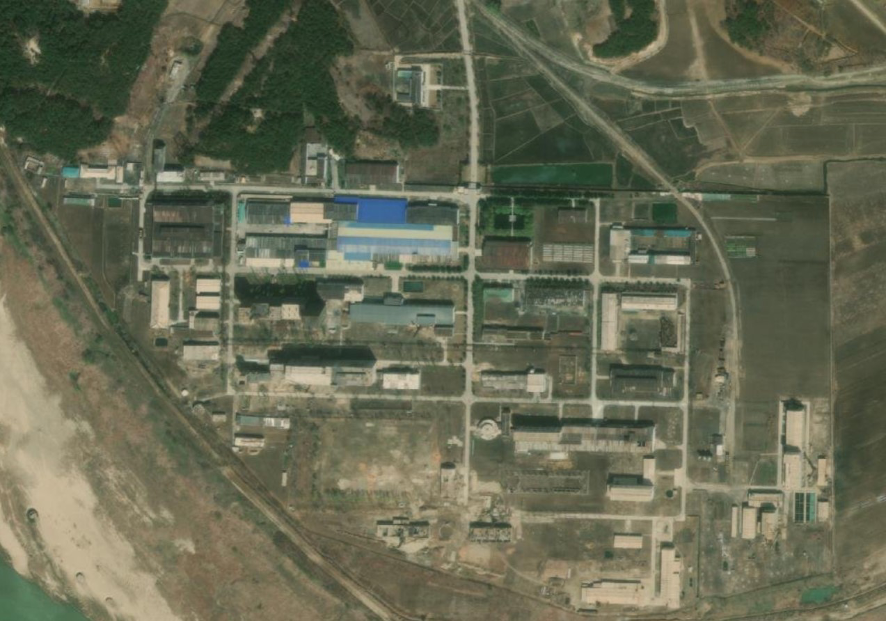
Source: Maxar (provided by Hajime Matsukubo, secretary general of the Citizens' Nuclear Information Center)
Satellite image 2: Nyungbyon Uranium Enrichment Facility(March 1, 2024)
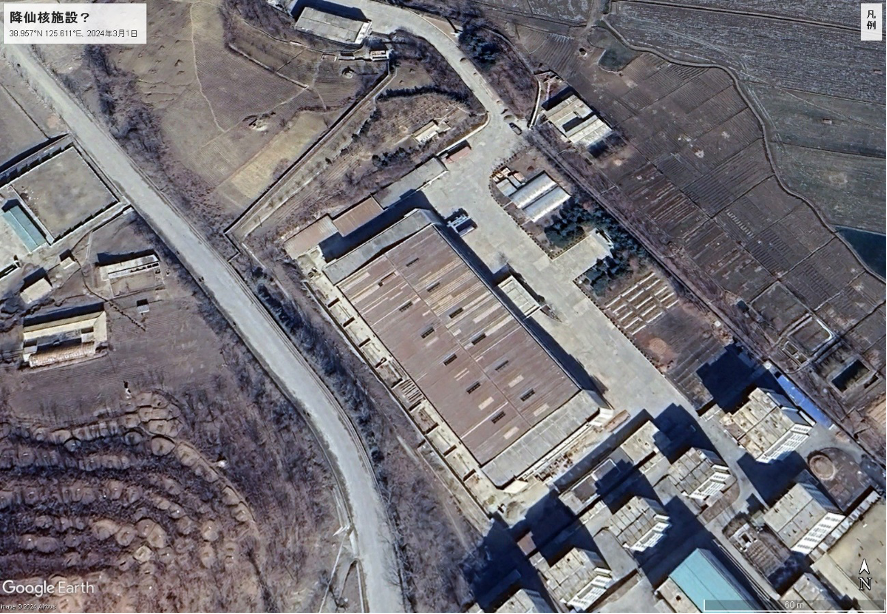
Source: Google earth pro (provided by Hajime Matsukubo, secretary general of the Citizens' Nuclear Information Center)
(2) North Korea's Aims and Intention
The first reason for Kim Jong-un's visit and guidance of the uranium enrichment facility was to strengthen the production of nuclear materials for nuclear weapons. Plutonium-based nuclear weapons require only 3.5 ± 0.5 kilograms per warhead, whereas uranium-enriched weapons require 22 kilograms per warhead to ensure the same level of explosive power and are not suitable for miniaturization. On the other hand, plutonium requires the establishment of a special technique called "implosion"[8] to detonate, and if this technique cannot be established, the bomb will not detonate. Uranium has the advantage that it can be detonated without fail if the two masses hit each other.
It is difficult to motivate nuclear powers such as the U.S., China, and Russia, which have conducted dozens or even hundreds of nuclear tests and have fully established implosion technique, to enhance their uranium-type nuclear warheads. However, North Korea has conducted only six nuclear tests, and it is impossible to conclude whether it has established detonation technique. In light of these circumstances, the Stockholm International Peace Research Institute (SIPRI) noted in its Yearbook 2024 that North Korea has a motive to increase its production of enriched uranium. Specifically, North Korea currently possesses 50 nuclear warheads, an estimated 70% increase from a year ago, but only about 60~80 kilograms of nuclear weapon-grade plutonium, enough for about 20 nuclear warheads. In addition, given the possibility that it has not yet established the technique for implosion, it will be necessary to increase the production of enriched uranium and uranium-type nuclear warheads in order to enhance its nuclear capability.
Table 2:Number of nuclear warheads and nuclear material for nuclear weapons held by North Korea (estimated)
| Number of nuclear warheads |
Nuclear-weapon-grade plutonium |
HEU |
|---|---|---|
| 50 | 60~80kg | 280~1500kg |
Source)SIPRI Yearbook2024
4. Implications for Japan and the International Community
With the recent disclosure of the uranium enrichment facility by North Korea, it can be seen that the number of centrifuges and the size of the facility have expanded considerably compared to the early 2010s (see Table 1). It can be said to have given a renewed impression that the denuclearization of North Korea has become even more difficult.
Japan calls on the international community to begin negotiations on a Fissile Material Production Ban Treaty (FMCT) as soon as possible and for the nuclear weapon states to declare a moratorium on the production of fissile materials until the negotiations are concluded.[9] However, prospects are not promising, and it is even less likely that North Korea will comply. Even if the nuclear powers, including North Korea, were to accept Japan's call, it would have the effect of preventing further increases in the number of nuclear warheads in the world, but the issue of how to reduce the number of nuclear warheads they already possess would remain. It will be necessary to reconsider whether Japan can produce enough materials and means with the United States and South Korea to convince North Korea to denuclearize.
(ENDS)
1 “KBS World “IAEA: Kangson Complex Shares Infrastructure Characteristics with Yongbyon Uranium Enrichment Facility” June/04/2024 [https://world.kbs.co.kr/service/news_view.htm?lang=e&Seq_Code=185838]
2 “IAEA Director General Statement on Recent Developments in the DPRK’s Nuclear Program” December/21/2023 [https://www.iaea.org/newscenter/pressreleases/iaea-director-general-statement-on-recent-developments-in-the-dprks-nuclear-programme]
3 This section is based on "What is Uranium Enrichment," Japan Nuclear Fuel Web page (in Japanese). [https://www.jnfl.co.jp/ja/business/about/uran/summary/] (in Japanese) and an interview with Tomonori Iwamoto, Secretary General, Institute of Nuclear Materials Management (INMM) Japan Chapter, September 13, 2024.
4 Following a nuclear test by neighboring India in 1974, Dr. Khan became head of Pakistan's uranium enrichment program in 1975. In 1976, while working for Urenco, a British-German-Dutch consortium engaged in uranium enrichment, he stole confidential information on centrifuge production methods and left the Netherlands. Pakistan successfully conducted a nuclear test in 1998, but in order to procure the materials and equipment necessary to manufacture nuclear weapons, he formed a "nuclear black market" and is said to have sold the stolen confidential information to North Korea, Iran, Libya, and other countries. He died in October 2021. No. 19 Atomic Energy Commission E-Newsletter November 14, 2008. [https://www.aec.go.jp/mailmagagine/backnumber/2008-1114.html]
5 Osamu Sudo, "Trends in Overseas Uranium Enrichment Companies," Japan Atomic Energy Agency (JAEA) Nuclear Energy Overseas Topics, March 14, 2013 (in Japanese). [https://www.jaea.go.jp/03/senryaku/topics/t13-1.pdf]
6 Yuki Kobayashi “Can the China-Russia Nuclear Energy Agreement Put the Brakes on Beijing’s Nuclear Weapons Buildup?” October 11, 2024 [https://www.spf.org/spf-china-observer/en/document-detail057.html]
7 38NORTH “A Closer Look at North Korea’s Enrichment Capabilities and What It Means” September 18 2024 [https://www.38north.org/2024/09/a-closer-look-at-north-koreas-enrichment-capabilities-and-what-it-means/]
8 A method of detonating a bomb by applying pressure evenly around the entire perimeter by means of a shock wave. Nuclear tests are conducted with the major objective of establishing implosion technology. ATOMICA “Implosion” [https://atomica.jaea.go.jp/dic/detail/dic_detail_598.html]
9 Delegation of Japan to the Conference on Disarmament “FMCT” [https://www.disarm.emb-japan.go.jp/itpr_ja/chap8.html]





